Discipline Letter For Students
Subject: Discipline Letter
Dear [Student's Name],
I hope this letter finds you well. I am writing to address some concerns regarding your recent behavior, which has been brought to our attention by [specific incident/behavior]. As a student in our school/organization, it is important to maintain a respectful and responsible attitude towards your studies, fellow students, teachers, and the overall learning environment.
The incident/behavior that occurred on [date] was in clear violation of our school/organization's code of conduct, specifically [mention the specific rule or policy that was violated]. Such behavior not only disrupts the learning environment but also reflects poorly on your personal growth and development as an individual.
We take disciplinary matters seriously and believe in providing a supportive environment for all students. It is important for you to understand the consequences of your actions and the impact they have on both yourself and others. Consequently, the following disciplinary measures will be implemented:
1. [Specify the disciplinary action, such as detention, suspension, or another appropriate consequence].
2. [Provide any additional steps or actions that need to be taken, such as a meeting with a counselor or completion of a behavior improvement program].
I would like to emphasize that this letter serves as a formal warning, and any future incidents or violations of the school/organization's code of conduct may result in more severe consequences, including further disciplinary action, parental involvement, or even dismissal from the school/organization.
I encourage you to reflect upon your actions and understand the importance of making responsible choices. Should you require any support or have any concerns, please feel free to approach [appropriate contact person or office] for guidance and assistance.
We believe in your potential for growth and improvement, and we hope that you will make the necessary changes to align with the expectations of our school/organization. We trust that you will take this matter seriously and make a sincere effort to demonstrate improved behavior in the future.
Thank you for your attention to this matter.
Sincerely,
[Your Name]
[Your Position/Title]
[School/Organization Name]
Formal Discipline Letter for Minor Misbehavior
Subject: Notice of Student Misbehavior
Dear [Student Name],
This letter is to formally address an incident of misbehavior observed on [date]. It has been reported that you [describe the behavior], which is not in accordance with the school rules.
We request your cooperation in correcting this behavior. Continued violations may result in further disciplinary action. Please acknowledge receipt of this letter and make the necessary adjustments.
Sincerely,
[Teacher/Principal Name]
[School Name]
[Contact Information]
Warning Letter for Repeated Misbehavior
Subject: Warning Regarding Repeated Misbehavior
Dear [Student Name],
We have noticed a pattern of inappropriate behavior, including [list incidents], despite previous verbal warnings. This letter serves as a formal warning that any further infractions will lead to stricter disciplinary action.
You are encouraged to meet with [teacher/counselor] to discuss steps for improvement. Cooperation and adherence to school rules are expected immediately.
Sincerely,
[Teacher/Principal Name]
[School Name]
[Contact Information]
Disciplinary Action Letter for Serious Offense
Subject: Disciplinary Action Notification
Dear [Student Name],
This letter informs you that due to your involvement in [serious offense], the school has decided to impose disciplinary action effective immediately. The action includes [detention/suspension/other measures].
A meeting with your parents/guardians and school authorities is scheduled on [date] to discuss your behavior and future conduct expectations. Compliance with the outlined measures is mandatory.
Sincerely,
[Principal Name]
[School Name]
[Contact Information]
Informal Email Warning for Classroom Misconduct
Subject: Classroom Conduct Reminder
Hi [Student Name],
I wanted to touch base regarding your behavior in class on [date]. Please remember to follow classroom rules and respect your peers and teachers.
Let's work together to ensure a positive learning environment. Thank you for understanding.
Best,
[Teacher Name]
[School Name]
Heartfelt Letter Encouraging Behavior Improvement
Subject: Encouragement to Improve Conduct
Dear [Student Name],
We believe in your potential and want to help you succeed. Recently, your behavior such as [specific incidents] has caused concern. This letter is meant to guide and encourage you to make better choices.
Please take this as an opportunity to reflect and improve. Support is available from your teachers and counselors to help you stay on track.
Warm regards,
[Teacher/Principal Name]
[School Name]
[Contact Information]
Quick Reminder Letter for Minor Violations
Subject: Reminder About School Rules
Dear [Student Name],
This is a quick reminder to follow school rules regarding [specific behavior]. Please make necessary adjustments to avoid further action.
Thank you for your cooperation.
Sincerely,
[Teacher/Principal Name]
[School Name]
What / Why: Purpose of a Discipline Letter for Students
- Communicates clearly that certain behaviors are unacceptable.
- Provides a formal record of incidents for accountability.
- Encourages correction and adherence to school rules.
- Serves as a reference for parents, teachers, and school administration.
Who Should Send a Discipline Letter
- Teachers for classroom-level issues.
- School counselors for behavioral guidance.
- Principals or administrative staff for serious or repeated offenses.
- Any authorized school personnel responsible for student welfare.
Whom the Letter Should Be Addressed To
- The student directly.
- Parents or guardians in cases of serious or repeated infractions.
- Relevant school authorities if documentation is needed.
When to Send a Discipline Letter
- After minor or serious misbehavior.
- Following repeated warnings or verbal counseling.
- To document incidents requiring administrative action.
- When parental involvement is necessary for correction.
How to Write and Send a Discipline Letter
- Identify the behavior or incident clearly and objectively.
- Describe previous warnings or interventions, if applicable.
- State expected behavior and consequences of non-compliance.
- Choose tone based on severity: formal for serious, informal for minor issues.
- Send via printed letter for official documentation or email for quick reminders.
Requirements and Prerequisites Before Writing
- Gather detailed records of the incident(s).
- Verify facts with staff or witnesses if necessary.
- Ensure knowledge of school rules and disciplinary policy.
- Have parental contact information ready for serious cases.
- Obtain approval from higher authority if required.
Formatting Guidelines for Discipline Letters
- Length: Concise but detailed; 150–300 words recommended.
- Tone: Serious for formal warnings; supportive for improvement-focused letters.
- Style: Clear, objective, and structured.
- Mode: Printed letter for formal record; email for quick reminders.
- Etiquette: Respectful language; avoid emotional bias; include contact info for follow-up.
After Sending / Follow-Up Steps
- Confirm receipt with student and/or parents.
- Schedule meetings if needed to discuss behavior.
- Monitor improvement or recurrence of behavior.
- Keep copies in student records for future reference.
Tricks and Tips for Effective Discipline Letters
- Be specific about incidents and behavior rather than generalizing.
- Use a positive tone when encouraging improvement.
- Include clear consequences for repeated misbehavior.
- Personalize letters to maintain student engagement.
- Avoid harsh or insulting language to maintain professionalism.
Common Mistakes to Avoid
- Sending letters without verifying facts.
- Using overly harsh or judgmental language.
- Omitting next steps or expectations for improvement.
- Not documenting minor incidents consistently.
- Neglecting parental notification when appropriate.
Elements and Structure of a Discipline Letter
- Subject: Clear purpose of the letter.
- Greeting: Address the student directly.
- Description: Explain the incident or behavior.
- Reference: Mention prior warnings if applicable.
- Expected Action: Outline required behavioral changes.
- Consequences: State possible disciplinary measures.
- Closing: Polite yet firm ending.
- Signature: Teacher, counselor, or principal with contact info.
- Attachments: Reports, incident logs, or policy references if needed.
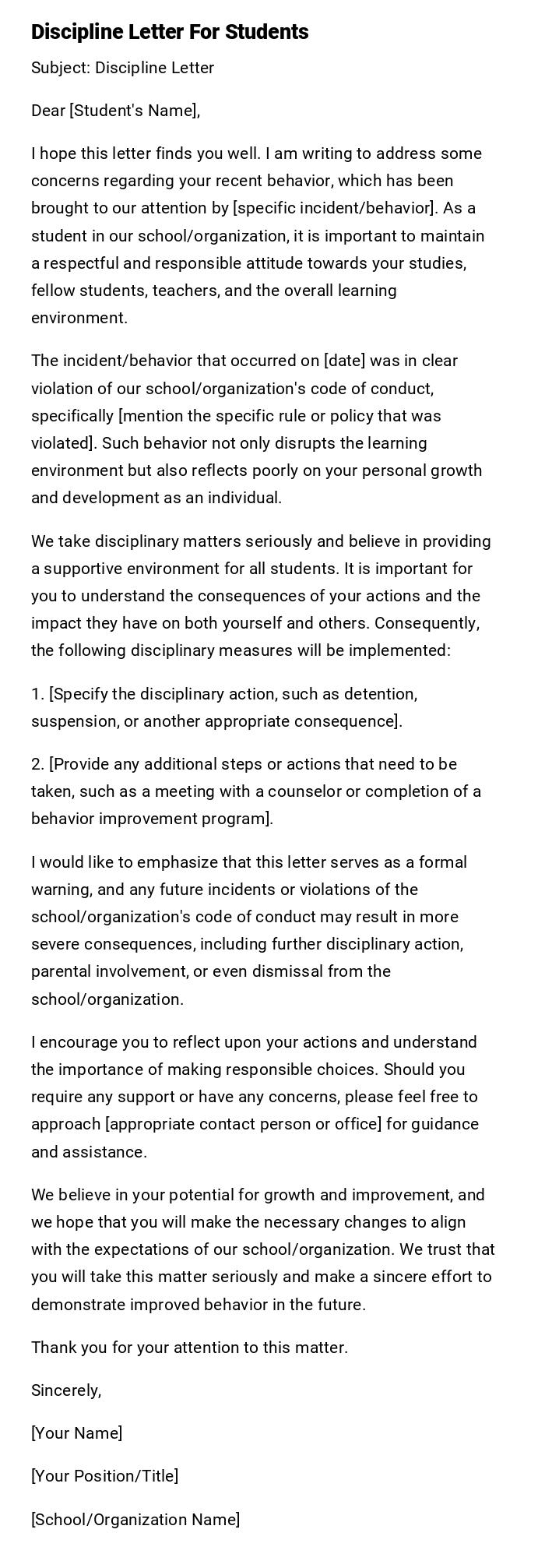
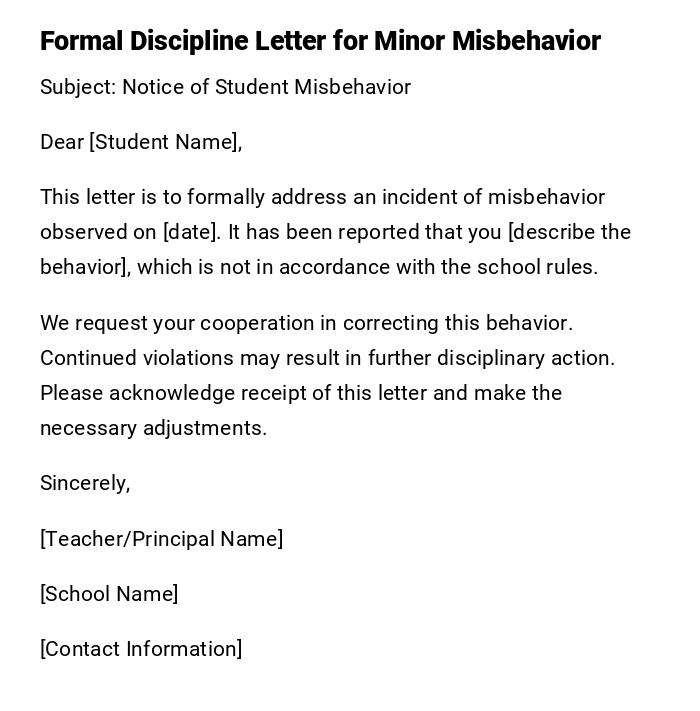
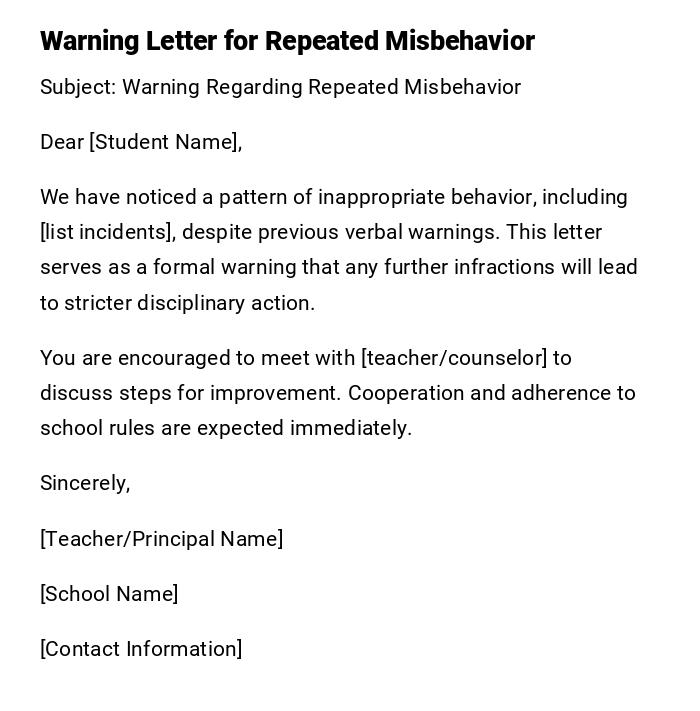
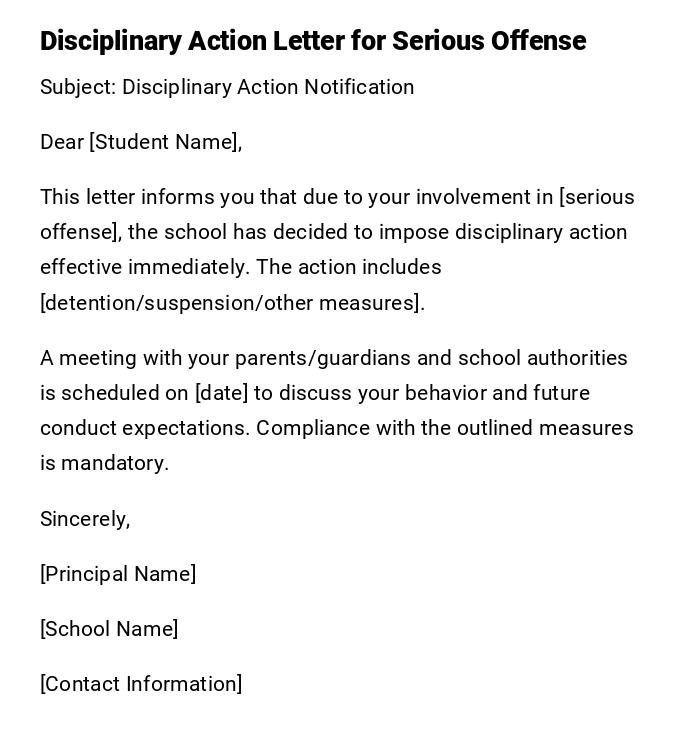
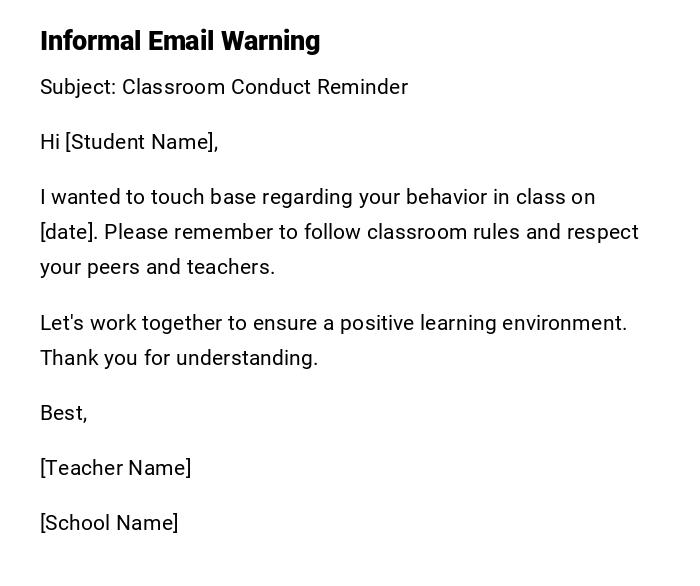
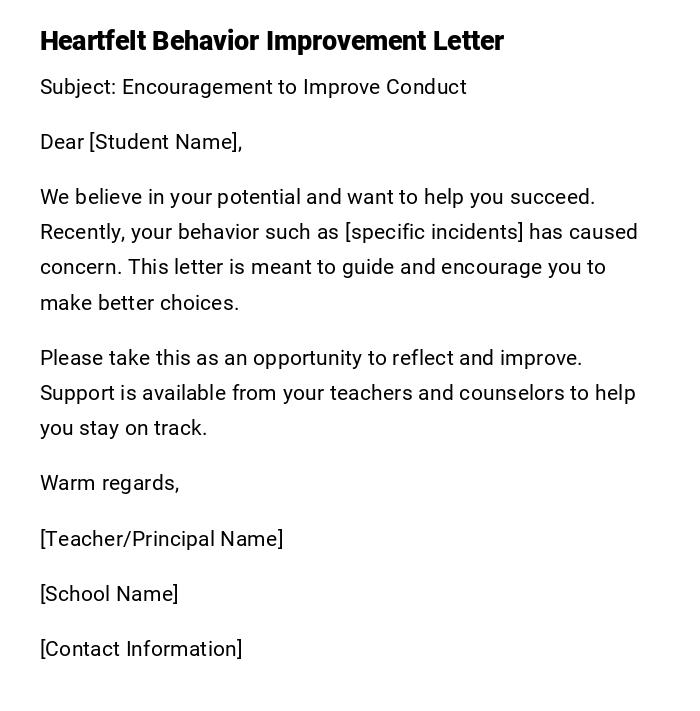
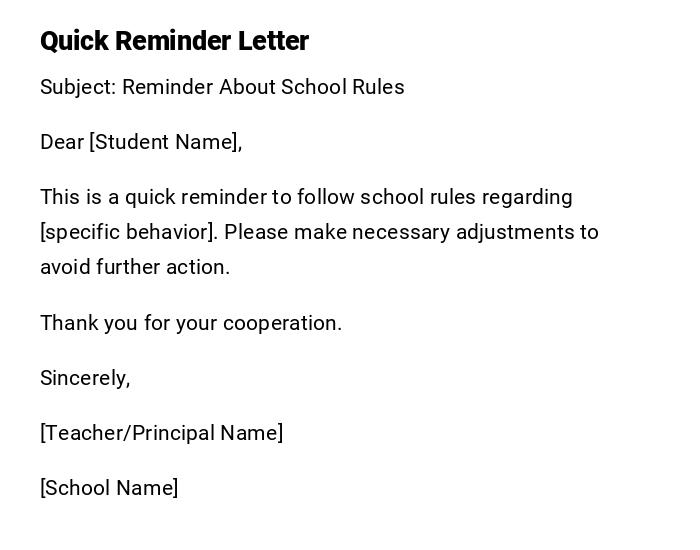

 Download Word Doc
Download Word Doc
 Download PDF
Download PDF